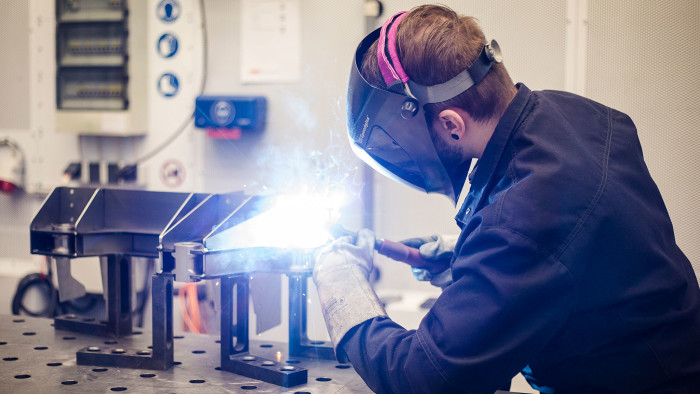Trumpf’s in-house invention turns rivals into potential clients

Roula Khalaf, Editor of the FT, selects her favourite stories in this weekly newsletter.
In Germany it is not uncommon to come across an industrial giant that plays a critical role in the global economy.
One of them is Trumpf. And though you might not be familiar with the name there is a decent chance your coffee machine, showerhead or car door frame was made using its products.
The Ditzingen-based company is a leader in “high-technology” machine tools and laser-cutting machines used around the world to form shapes out of metal. But it has recently taken an early lead in Industry 4.0 — the so-called fourth industrial revolution, comprising the internet of things, machine learning and “smart” factories.
While Trumpf is larger than the average Mittelstand (small and medium-sized) company, with more than 11,000 employees and €2.8bn in annual revenue, its recent experience could serve as an example for other machinery companies who want to exploit the world of data analytics to enhance their business offerings.
In Ditzingen, employees on a sensor-equipped shop floor move from one project to another after receiving instructions via cloud messaging on their smartphones. When someone moves a set of materials a QR code scan marks completion of the task, rendering paper useless.
Trumpf claims that digitising these tasks has trimmed downtime enough to boost efficiency by 10 per cent-20 per cent. The programme has only been in place since March, but Trumpf plans to roll it out to its 71 subsidiaries around the globe. Nicola Leibinger-Kammüller, chief executive of Trumpf since 2005, says the company’s significant push towards digital connectivity is part of an effort to maintain an edge.
Central to Trumpf’s efforts to move to Industry 4.0 was the launch, in early 2015, of Axoom, a browser-based digital platform for integrating logistics. Axoom digitises tasks, enabling users to track inventory, reorder materials and choose the best-value shipping solutions.
Stephan Fischer, who joined Trumpf to 2014 as head of software development says that at the time up to 90 per cent of logistics work was being done on paper and most digital tasks were done in Excel.
To improve efficiency, he says he researched possible digital platforms, but quickly discovered there were none to choose from. “We were crazy enough to say, ‘Let’s build our own,’” he says. All it took was convincing management — a 15-minute meeting — and then creating it. From scratch.
Mr Fischer says it was obvious from the start that it could be employed not only by Trumpf but by any machinery maker. Now, more than 20 companies are using it and a pipeline of new clients has signed up to be next, he says.
Axoom now has about 100 employees. The Karlsruhe-based offshoot marks a complete departure from how Trumpf has been making its bread-and-butter since 1923.
“This is totally changing the game, because it has nothing to do with the machines that we have [built] in the past,” Mr Fischer says.
The shift has helped to turn challenges into opportunities. In 2005, Trumpf had eight competitors in two-dimensional lasers. Today, it has 150, but for Axoom these new competitors are all potential clients.
Axoom is developing tools to help with “predictive maintenance”. It has also launched an app store, partnering with more than 50 companies to improve workflows and perhaps even become the Apple of machinery logistics, Mr Fischer says.
Investing in new technologies has come at a cost for Trumpf. Research and development spending jumped 11.7 per cent in the year to June, to €296m. That is one reason why net income fell 12.8 per cent to €235m, even as revenues rose 3.4 per cent to €2.81bn. But Trumpf argues these are bold investments designed to pay off in the long term, as Industry 4.0 activities such as Axoom generate new lines of revenue.
“The one who owns the platform will basically dictate what’s going on, and now we have one of those platforms,” Mr Fischer says. “It’s that simple.”
Comments